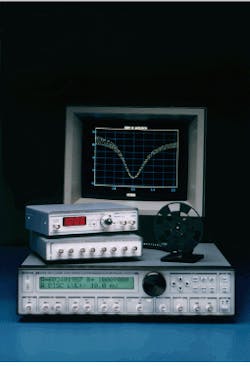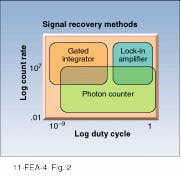Pick an analyzer to fit your signal application
Signal analysis basics are covered in any college circuit-theory course. However, applications such as analyzing pulsed-laser-induced effects ranging from material fluorescence to transient biomedical phenomena may require rather skillful and specific applications of this relatively mundane discipline. Versatile equipment is available for a range of data-gathering situations (see Fig. 1).
Many desired signals are mired in a sea of noise from various sources including the experiment itself, the support equipment, and the environment of the laboratory or production area. Fortunately many techniques are available to neutralize extraneous signals. Methods include modulating the desired input in order to identify it in a busy detector output, averaging and integrating "quality" data points to build up "wheat" to allow discarding the "chaff" of noise, and determining the noise signals and subtracting them from the overall detector signal.
Current analysis instrumentation extends over a wide spectrum of capability and costs—from research centers pushing the limits of particle and photon detection to systems geared to a more spartan college undergraduate teaching laboratory. This Product Focus is representative of several types of signal analysis equipment on the market. A table following the article lists some of the companies providing lock-in amplifiers, boxcar averagers, and gated integrators and a sampling of their systems. It is not meant to be a comprehensive inventory. For a more detailed listing of manufacturers see the 1995 Laser Focus World Buyers Guide, p. 329. Prospective buyers should contact individual vendors for information on various product lines and selection criteria.
Sorting through the choices
Your choice of method for detecting signals will depend on several considerations including signal intensity, its time and frequency distribution, and the nature of noise sources with their own time and frequency characteristics. The main factor is usually the signal time behavior.
While direct-current (dc) techniques are inexpensive and accurate, they inherently have error sources that preclude their use. Electronic components and energy sources have an electromagnetic noise spectrum that is inversely proportional to frequency (1/f). Thus below a certain frequency a dc voltmeter will be affected to a degree dependent on its internal filters. Also an alternating current (ac) interference frequency may be low enough to pass though the voltmeter input filter and cause drift in the meter. Even at higher frequencies, if the amplitude is high enough, the meter can rectify the interference producing an error in readings. Finally, constant error sources, such as extraneous light in a room during spectroscopy measurements, can produce dc offsets in the voltmeter.
Alternating-current-based measuring techniques obviate extraneous dc inputs and 1/f noise. Now the frequency(ies) of the desired signal(s) and the elimination of "noise" of other frequencies will drive the selection of signal analysis systems and raise the issue of measurement bandwidth. An oscilloscope can be used to display a signal, and digitizing types can improve signal-to-noise ratio with averaging. A drawback to oscilloscopes, however, is their large bandwidth, which prevents very sensitive measurements—signals up to a few hundred megahertz that pervade the average room can be displayed. An ac voltmeter, while useful, will not work well measuring a small single-frequency signal surrounded by noise at many frequencies. A filter can aid in noise rejection but would not have the frequency selectivity of frequency-domain-based instruments, such as wavelength, network, and spectrum analyzers. Of the spectrum analyzers, the lock-in amplifier offers high dynamic range, selectivity, low internal noise, and reasonable cost.
Lock-in amplifiers
If the signal is fixed in frequency and has at least a 50% duty cycle (that is, more than half the time the signal has a nonzero value), then lock-in detection is most suitable (see Fig. 2). Many investigators also consider it standard procedure to use an optical chopper in conjunction with a lock-in for modulating the signal to separate it from unmodulated noise (see Laser Focus World, November 1994, p. 107). A lock-in measures an ac signal and produces a dc output proportional to the ac signal. Because the dc output level is usually greater than the ac input, a lock-in is termed an amplifier. The unit "locks into" and measures a particular frequency while filtering out input from other frequencies.A demodulator, or phase-sensitive detector (PSD), is the basis of a lock-in amplifier. This circuit rectifies the signals coming in at the desired frequency. The PSD output is also a function of the phase angle between the input signal and the amplifier`s internal reference signal generated by a phased-locked loop locked to an external reference that also drives, for example, laser energy exciting a sample. Thus the lock-in can also gauge the phase relationship of two signals at the same frequency.
In use, the lock-in gain is adjusted to produce a specific sensitivity at full-scale reading. However, the input circuits can accommodate signals many times larger than these calibrated maxima, allowing the instrument to measure signals submerged in unwanted noise. Dynamic reserve is a measure of this lock-in capability to recover signals buried in noise and is given as the ratio of the largest tolerable noise signal to the full-scale signal.
A dynamic reserve of 60 dB would mean that noise 60 dB greater than full scale can be tolerated at the input without overload. To achieve high reserve, the input signal gain is set very low so noise overload is not likely. A lowpass filter then removes the large-noise components from the PSD output, permitting the remaining dc component to be amplified to full-scale values.
Digital vs. analog lock-ins
There are digital and analog lock-ins available. A digital type multiplies the input signal with the reference sine wave digitally and is insensitive to signals at harmonics of the reference. An analog PSD multiplies the signal by an analog reference wave where dc offsets from the noise signal may show up directly as a variation in overall gain. And analog sine wave generators may be subject to drift as a function of temperature.
Some digital lock-in amplifiers may have various degrees of jitter in their output if the analog-to-digital converter is asynchronous. The jitter arises from the "sum and difference" frequencies produced by the detection process resulting in the PSD output having both an ac and a dc component, even without noise being present. The ac component, or ripple, results in sampling the output as the ripple varies between its maximum and minimum. If the sampling is done synchronously with the reference frequency the sampled data does not then vary with the ripple. The ripple could also be reduced by increasing the output time constant, but then the data stream is slowed down.
When setting up a lock-in amplifier for an experiment, the prime consideration is the excitation frequency. This frequency is limited by the properties being measured and the limitations of the equipment being used. In general, making the excitation frequency as high as possible works best because lock-in internal 1/f noise and measurement response time will be minimized. Care should be taken to avoid using harmonics of the power line or any other frequency unique to the experiment.
Optical detectors that can provide signals to lock-in amplifiers include photomultiplier tubes (PMTs) and photodiodes. Both types are good current sources with low noise. Noise from PMTs is even lower than noise from the diodes but precautions must be taken in a PMT setup to avoid charge build-up from improper grounding as well as high currents from ambient light falling on the detector.
Boxcar averagers and gated integrators
If a signal is of short duration then boxcar averaging and gated integration are good choices for signal recovery. As an example, a laser may be used to excite low-level fluorescence in a sample via short pulses in the nano- to microsecond range at repetition rates up to 10 kHz. Here the duty cycle is well under 50%. The fluorescence pulse extends past the laser pulse and produces a photocurrent in a detector. To maximize the signal-to-noise ratio to improve extraction of the low-level signal, the current over successive laser pulses can be averaged or its value over a given number of pulses can be summed. The averaging mode is termed boxcar averaging while the summing mode is called gated integration.
The detector photocurrent is amplified and fed to the averager/integrator. A pulse generator forms the gate when triggered by a timing signal that also fires the laser. A delay generator ensures timing the gate and the light pulse to allow photocurrent accumulation or averaging. In the boxcar mode, about 10 pulses will allow the averager to exponentially reach a steady-state voltage proportional to the integrated light signal. Thus a 20-Hz laser-repetition rate gives a 0.5-s response time, which increases with higher repetition rates. The voltage remains constant until the light intensity on the detector changes. The boxcar mode is useful for recording time-varying light intensities with a chart-type recorder or display, as with measuring spectra using time-resolved scanning monochromators in addition to the fluorescence work noted.
In the gated integrator mode, the output of the integrator increases linearly with successive light pulses to a preset number of events. The integrator is zeroed, and the integration cycle starts over after the last pulse in the train. This technique serves well when the detected signal is extremely weak.
For very low signal intensities, well under one photon per gate or cycle, photon counting must be used. This is done with PMTs or lower-voltage and higher-quantum-efficiency avalanche photodiodes (APDs). To reduce dark current for the high signal-to-noise ratio needed, APDs must be cooled, often to cryogenic temperatures. Higher counts will saturate the detector output and lock-in, boxcar, and gated methods are required. The technique to use for a middle range of situations would hinge on signal-to-noise ratio necessary to extract useful data.
Insights and tips
Manufacturers of signal analyzers have some interesting comments about the nature of the market for signal-recovery instruments. Sandy Lewis, sales and service coordinator for DL Instruments (formerly Ithaco, Dryden, NY) notes that despite the number of devices available, "a basic lock-in is lacking on the market" for OEM applications for people building signal analysis systems. She notes that there is also a dearth of lock-in amplifiers for applications above 10 MHz. Lewis observes that some researchers prefer either digital lock-ins with computer control or analog units with the ability to be "tweaked" using knobs and a meter, to the exclusion of the other type. This limits a user to only half the capability on the market because the results would be "virtually the same" because the basic principle is identical for both.
Some providers serve only niche markets. John Talmage, president of Comstock (Oak Ridge, TN) says his company`s affordable boxcar integrator is "a low-end product for people doing slow laser experiments in undergraduate teaching labs where the 50-ns minimum window is useful." Similarly, Ken Duval of Laser Science (Newton, MA) says his company`s device is "very basic and designed to be used with our pulsed nitrogen and dye lasers" in undergraduate physics and chemistry laboratories. Duval generously adds, "I have used the Stanford Research Systems (Sunnyvale, CA) catalog to recommend equipment to our customers who need greater measurement flexibility. The catalog has tech notes, including one on pulsed-laser data acquisition, and application notes."
Whatever a signal analysis need may be, systems available on the market today should offer reasonable choices for almost any need, preference, and budget consideration.
About the Author
Rick DeMeis
Associate Editor, Technology
Rick DeMeis was Associate Editor, Technology for Laser Focus World from March 1995 through March 1997.

